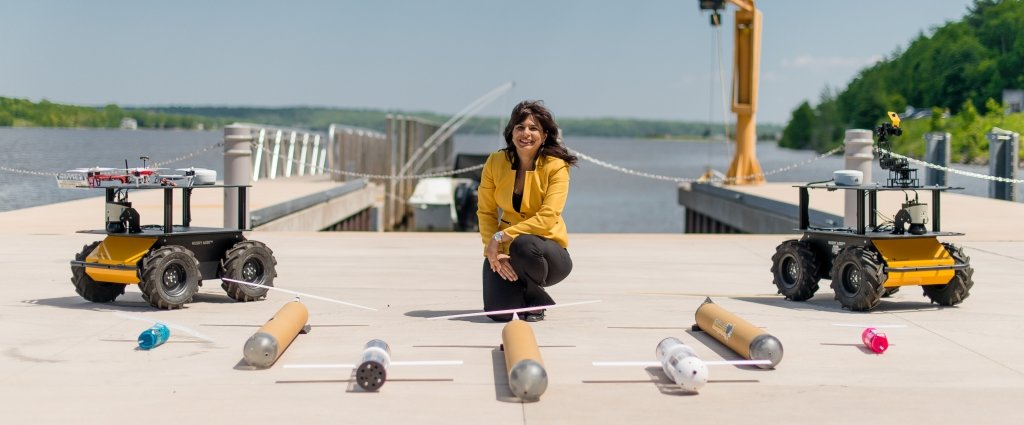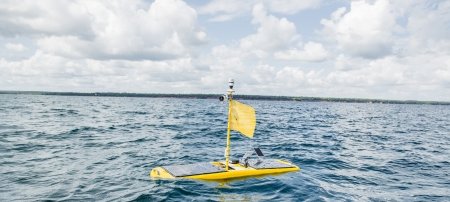SURFing for the Summer

Hiking to waterfalls, enjoying the beaches of Lake Superior, getting ahead of schedule with summer classes—all things that a summer at Michigan Technological University has to offer. As it turns out, developing a new autonomous underwater glider is also on the list.
Through a Summer Undergraduate Research Fellowship (SURF) and the guidance of his mentor, Nina Mahmoudian, assistant professor of mechanical engineering–engineering mechanics, third-year mechanical engineering student Brian Page is working to develop two autonomous underwater gliders. One is called a Glider for Underwater Problem-solving and Promotion of Interest in Engineering (GUPPIE). It’s about 18 inches long. The other is a Glider for Autonomous Littoral Underwater Research (GALUR) and measures about 3 feet in length.
“The smaller glider will primarily be used for education—sort of an inspiration for younger kids,” says Page. “It might also be used by undergraduate and graduate students here at Tech who are researching control systems.”
The GALUR has applications in naval surveillance, as well as measuring water characteristics such as depth and salinity. Both of the gliders use changes in buoyancy and a small battery-operated water pump to propel themselves.
“In addition to environmental monitoring, underwater gliders are increasingly depended on for littoral surveillance and other military applications,” says Mahmoudian. “The Navy is operating these gliders to rapidly assess and exploit environmental characteristics to improve the maneuvering of ships and submarines.”
While in the water, the gliders use sensors to monitor water current and depth to find the best route to their programmed target. The gliders are also equipped with sonar to detect obstacles in the water so that they can safely navigate around them.
“We are developing a framework for controlling gliders in harsh, dynamic environments and advancing efficient, collaborative behavior of autonomous underwater vehicles,” explains Mahmoudian.
The ultimate goal of the research is to create an entire fleet of gliders that would work together as a swarm. This would enable the gliders to accomplish tasks more quickly and over a larger area. However, Page’s main focus for this summer is redesigning the GUPPIE and optimizing its cost.
“I’m redesigning it to be more user-friendly,” says Page. “The parts for the new design will be made using a 3-D printer, and the glider will be easier to assemble.”
Working on the gliders is Page’s first research experience, and it’s given him a whole new perspective on engineering. He says that seeing the entire engineering process in action has been beneficial.
“It’s given me practice with designing and coming up with new ideas to solve problems,” says Page. “Working on the gliders has really shown me how things work in a lab, and how much goes into the research and development process.”
Page has a co-op lined up for next year. He is looking forward to getting a taste of industry to compare with his experience in the lab this summer.
“I’m up in the air about whether I want to stay in academia or go into industry after I graduate,” he says. “I think both have their perks, and I think this will help me decide.”
Page is one of 26 students at Michigan Tech who received SURF awards this summer.
In another SURF project, fifth-year biomedical engineering student Nicole Westphal is working with her mentor, assistant professor of biomedical engineering Rupak Rajachar, to create hydrogels that can deliver cells directly to the site of a tendon injury or skin wound. Once at the site of the injury, these cells can shorten the healing time.
“We’re trying to create a way to get cells directly into a wound,” says Westphal. “The cells can speed up recovery, and this gel would allow them to get into the action.”
The hydrogel is made of a protein called a fibrinogen and a polymer called polyethylene glycol (PEG). When combined, these two components can hold living cells. The gel could help patients get back on their feet faster, as well as prevent infections.
“The particular hydrogel that Nicole is working on will be used as a cell delivery vehicle for the repair of tendon injuries,” says Rajachar. “It also has applications as an antimicrobial in skin wounds.”
After graduating next spring, Westphal hopes to attend medical school. She believes that her research experience will be invaluable to her as she pursues a career as a physician.
“Doing research helps me see things from a different perspective,” she explains. “It adds a completely new dimension to medicine, which is cool.”
The SURF program funds undergraduate student research with faculty mentors for approximately 10 weeks each summer, with funding from the Office of the Vice President for Research and the Honors Institute. Since SURF’s inception in 2002, students have completed research projects that have led to at least 44 peer-reviewed publications and several presentations at national and international conferences. The stipend is currently $3,300.
Michigan Technological University is an R1 public research university founded in 1885 in Houghton, and is home to nearly 7,500 students from more than 60 countries around the world. Consistently ranked among the best universities in the country for return on investment, Michigan's flagship technological university offers more than 120 undergraduate and graduate degree programs in science and technology, engineering, computing, forestry, business, health professions, humanities, mathematics, social sciences, and the arts. The rural campus is situated just miles from Lake Superior in Michigan's Upper Peninsula, offering year-round opportunities for outdoor adventure.




Comments